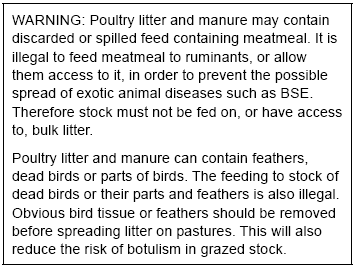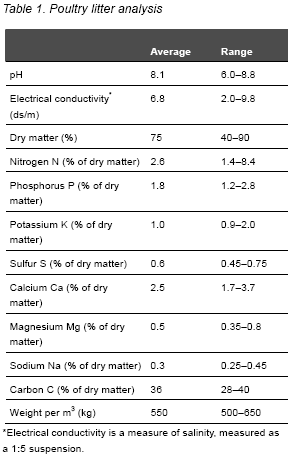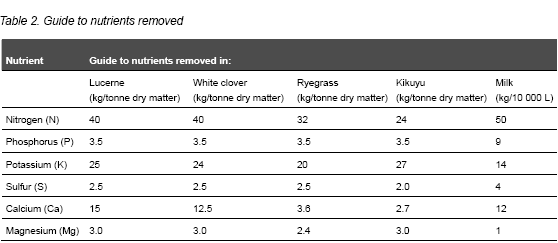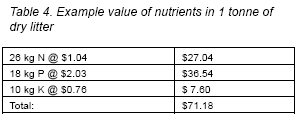



Best practice guidelines for using poultry litter on pastures
By Neil Griffiths, District Agronomist, Extensive Industries Development and published by NSW Department of Primary Industries. |
Summary
Bulk poultry litter can be the basis of very productive and valuable pasture and agricultural production when used wisely. It also has potential to create human and animal health risks, plus cause dust, smell and water pollution if it is not stored, spread and managed in an appropriate manner. These guidelines aim at ensuring that you use poultry litter wisely to optimise pasture production and minimise the risk of problems concerning stock health, stock feeding bans, pollution and the environment.
- Poultry litter may contain human and animal pathogens, so good hygiene has to be practised when handling litter. Animals must be prevented from gaining access to litter. Care should be taken to prevent poultry litter contaminating fresh produce that would not be cooked prior to eating.
- The nutrient content of poultry litter varies. This variability must be reflected in its price compared with other forms of fertiliser. Poultry litter contains the major nutrients nitrogen, phosphorus and potassium, but it is not perfectly balanced for pasture requirements. It does not contain enough nitrogen for grass pastures compared with the phosphorus supplied.
- Wise fertiliser use combines nutrient budgeting (i.e. knowing what nutrients are being used and removed from a paddock) with soil testing (to check that the desired soil nutrient levels are being achieved).
- Poultry litter is light and will wash off paddocks easily. Take care when storing and spreading poultry litter to prevent it entering watercourses or moving to off-target areas. It may sometimes be possible to plough it into the soil; however, this practice destroys established pasture and increases soil erosion risk.
- Spreading litter onto a recently grazed or harvested pasture with 5–10 cm of stubble will help to hold the litter in place and reduce washing. To further protect waterways, maintain an unfertilised vegetated buffer 10–30 m wide around all boundaries and next to any watercourses. The width of the buffer will depend on slope, groundcover and sensitivity of the waterway to pollution.
- As a general guide, on intensive-irrigated pastures, expect to apply 15 m3/ha for the first 2 or 3 years, then soil test to check that phosphorus has risen to the desired level. Then expect to alternate 1 year poultry litter to 1 year nitrogen or potassium fertiliser if required. On less productive dry land or grazing paddocks, the same principle applies but less fertiliser may be required to maintain target fertility levels.
These guidelines should be appropriate in most situations; however, it is always the user’s responsibility to ensure that water is not polluted and offensive odours are not produced.
What is poultry litter?
Bulk poultry litter is a mixture of manure, bedding material and water. The proportion of each will vary depending on shed management. A typical analysis of poultry litter is given in Table 1.

Litter also contains trace elements including copper, zinc, manganese, boron and chloride.
Poultry litter containing dead birds or parts of birds should not be spread on pasture to ensure that dead birds or feathers are not eaten by stock (see Warning), and because of the risk of botulism in stock grazing that pasture. Botulism occurs in animals that ingest the neurotoxin produced by the anaerobic growth of the organism Clostridium botulinum, which can occur in decaying birds. Stock affected with botulism become paralysed and usually die. Note: Livestock may be vaccinated against botulism.
As a normal safety precaution, check that the bedding material does not contain chemicals that could cause a residue problem in livestock that may graze littered areas.
The nutrients in poultry litter are in both mineral and organic forms. This means a proportion of the nitrogen, phosphorus and potassium is immediately available to plants while the remainder (organic) must react in the soil to change into a form which is available for plant use.
Most of the nitrogen in poultry litter is available soon after spreading. Approximately 25% (range 10%–50%) is in the ammonia form which will be lost to the atmosphere unless cultivated or washed into the soil within a few days of spreading. If washed or incorporated into the soil by rain or irrigation, the nitrogen will soon become available for plant growth. Most of the other nitrogen in poultry litter becomes urea within a short time of spreading, and from then on acts similarly to urea fertiliser.
Excessive nitrogen should not be applied to pastures. It may leach into groundwater or wash into surface waters causing a potential health problem. Excessively high nitrogen levels in pasture may also be a poisoning risk for grazing animals and any sensitive native vegetation.
Approximately 13% (range 6%–30%) of the phosphorus in poultry litter is in a water-soluble form, which means that it is immediately available for plant use. The remainder is slowly released as organic fractions of the litter decompose, usually within a year of application. Leaching is not normally a problem because most soils bind phosphorus.
Potassium in poultry litter is readily available to plants. Some may be lost by leaching down into the subsoil if excessive rain or irrigation occurs.
Litter is normally alkaline with a pH around 8; however, compared with lime, it has a lower neutralising effect on acid soil. (The high pH is mostly caused by the ammonia contained in the litter.) Repeated use of poultry litter will maintain or slightly increase soil pH. On soils that are very acidic, mixing lime into the soil will improve pasture growth.
Moisture content in litter is variable, which is one reason why it is sold by volume (cubic metres) rather than weight (tonnes). Moisture content will affect the amount of dust and overlap required when spreading. It is also important when calculating the rate of nutrient being applied to a paddock.
Poultry litter is mostly organic matter. Organic matter helps hold moisture, improves soil structure, encourages organisms such as earthworms and will hold and supply nutrients. Any increase in organic matter will normally improve your soil.
Storing poultry litter
Spreading poultry litter directly from the shed at cleaning time minimises double handling and maximises nutrient value. Unfortunately, limited cleanout time, availability of equipment, weather conditions and availability of suitable land often means that litter must be stored for some time prior to spreading.
Proper storage of litter is essential to maintain its fertiliser value and minimise health and pollution risks. Poultry litter stored in large piles at incorrect moisture levels will heat up and lose nitrogen and organic matter. This is often seen as a blackened or ashy grey colour of the litter. In extreme situations large piles can ignite by spontaneous combustion.
Loss of nutrients during storage is also an environmental concern. Nitrogen and phosphorus can wash from stockpiles into streams or dams, or leach into groundwater.
Storage methods will vary depending on:
- local regulations
- amount to be stored
- time period
- weather conditions.
The cheapest and most common method is an open stockpile. A large stockpile has the greatest risk of nutrient loss and environmental pollution. For an open stockpile, select a well-drained site away from watercourses. Narrow stacks no more than 1.8 m high will reduce nitrogen and organic matter loss caused by overheating. Stock must not be allowed access to stacks, including compost stacks.
Nutrient losses and environmental pollution risk can be reduced by covering the stack with a roof or plastic sheeting. A compacted base and bunding will reduce run-off in sensitive locations near water bodies. A sediment fence could also be useful.
Composting poultry litter
Composting removes the majority of animal and human pathogens from the litter but does not eliminate the risk of botulism.
The composting of poultry litter should be managed so that the process is even and effective. Ideally it should have:
- a carbon to nitrogen ratio of 30:1
- a moisture content of 40%–50%.
A low carbon to nitrogen ratio will result in extensive loss of nitrogen, which would be a problem if straight poultry manure was used. Litter should be heaped in rows approximately 1.2 m high and 2.4 m wide to achieve temperatures of 60°C to 70°C. This temperature is enough to kill most human and animal pathogens except Listeria, Clostridium perfringens and Clostridium botulinum. If litter is stacked too deep, temperatures can exceed 95°C and result in fire.
Composting poultry litter may reduce the risk of nutrients from poultry litter entering watercourses. In practice, poultry litter is often partially composted during storage in heaps before it is spread onto crops or pastures. This may result in 45%–55% of the manure nitrogen being lost during storage. Composting reduces the weight and volume of the original material.
Although composted poultry litter may be a more valuable fertiliser than fresh poultry litter, kilo for kilo, it has the disadvantages of increased cost and time required for processing, and reduces the total amount of nitrogen and organic matter available for land application.
Farmers who use poultry litter on crops and pastures need to be aware of the effect of the composting process on nitrogen and organic matter availability. They need to be aware that losses will occur during storage and that these losses will increase if the litter is stacked too deep. In industries that are very cost-sensitive, it may be more profitable to apply fresh poultry litter, which minimises cost and maximises total nutrient input, and use other management strategies to ensure that nutrients from poultry litter do not enter watercourses.
Composting poultry litter would be economically justified if the composted product could be sold at a premium price for use in nurseries and gardens.
How much poultry litter to use
Typically, poultry litter is spread at a rate of approximately 15 m3/ha. Using the average analysis provided in Table 1, 15 m3 would supply 160 kg nitrogen, 111 kg phosphorus and 62 kg potassium. This is equivalent to 350 kg urea, 1260 kg superphosphate and 125 kg muriate of potash. Whether this amount of fertiliser is enough, not enough or too much depends on soil type, crop requirements and the amount of nutrient being removed in animal products, silage or hay.
In many situations it would be desirable to split the application of poultry litter into smaller amounts, possibly applied more frequently. The problem with this alternative is that it is either not possible or excessively expensive if contractors are used to spread the litter, and many spreaders are not able to spread smaller amounts (e.g. 6 m3/ha) evenly and efficiently. You need observation, a soil test and a nutrient budget to determine what rate of poultry litter to apply and to check that you are getting the desired result.
Soil test
You should have your soil tested for:
- pH
- electrical conductivity (salinity)
- phosphorus, sulfur, calcium, magnesium, potassium, sodium and aluminium – nitrogen may be included in this test package.
Test paddocks every 2 or 3 years. Samples should be taken at least 9 months after the last application of litter.
Where heavy rates of poultry litter are used, the amount of available phosphorus in the soil often exceeds desired levels. To save money and reduce the chance of environmental problems, you should temporarily stop using poultry litter or other fertilisers containing phosphorus if soil test results indicate that phosphorus levels are more than twice as high as the targets (e.g. more than 60 Bray or 120 Colwell). It is highly unlikely that pastures will respond to additional phosphorus if soil levels exceed these limits. Losses of phosphorus in run-off are more likely to occur if excessive phosphorus is applied to the soil.
Nutrient budgeting
Poultry litter is normally applied where high levels of production are desired. Using Table 2 you can calculate what nutrients are being removed from the paddock and then plan your fertiliser program to replace these nutrients.

Using poultry litter on pastures
Poultry litter can be used to fertilise all types of pasture. The best results are obtained from mixed pastures comprising grasses and legumes. The following special considerations also apply.
Poultry litter on lucerne or clover
Lucerne and clover respond very well to poultry litter. They contain large amounts of nitrogen, potassium and calcium. Poultry litter will supply ample phosphorus, but lack of potassium may limit legume growth. This will depend on the potassium content of the litter and the natural potassium level in the soil.
Lucerne and clover will use nitrogen supplied by poultry litter or, being legumes, fix their nitrogen requirement from the atmosphere. To prevent nitrogen being wasted, rotate legume paddocks with a grass pasture or forage crop, otherwise weeds will grow or nitrogen may leach, polluting groundwater and making soil more acid.
Poultry litter on kikuyu
Poultry litter works well on kikuyu. Litter will provide excess phosphorus compared with the amount of nitrogen and potassium required by kikuyu.
Nitrogen is normally the nutrient which limits kikuyu growth when temperature and moisture are right. Poultry litter will supply some nitrogen. Unless a vigorous legume such as white clover is also in the pasture, kikuyu will require extra nitrogen fertiliser such as urea to grow to its potential. If poultry litter is used to supply the full nitrogen requirement, then excess phosphorus will be applied – this is a waste of money and nutrient, and the excess phosphorus could become a pollution risk.
Grasses generally have a vigorous root system able to extract enough potassium from the soil. Kikuyu will not normally show an obvious response to extra potassium, but if you wish to grow white clover or lotus with kikuyu, extra potassium may be required.
Managing pasture that has received poultry litter
Pastures that have been fertilised with poultry litter are intended to produce large amounts of high quality forage. To be successful, this forage must be harvested or grazed at its optimum growth stage. If it is allowed to become old and rank, its feed quality will deteriorate, and because of trampling, shading and lodging, feed will be wasted.
Grazing
Do not graze pastures for at least 3 weeks after spreading poultry litter. This will normally coincide with the regrowth period if litter has been spread on a well-grazed paddock. The 3-week wait for new growth will minimise palatability problems and reduce any risk of disease carryover from the litter (such as salmonella or botulism).
In addition this 3-week period will ensure that animals do not ingest any poultry feed which may have been present in the litter, provided the litter has been applied at no more than the recommended rates.
If regrowth does not occur within 3 weeks, then stock should be kept off the paddock until it does.
Spread poultry litter on high quality improved pastures. In general, graze grass-based pastures when they are short and have maximum quality. The optimum is usually 15–20 cm in height and before there is any yellowing or death of shaded lower leaves.
Rotational grazing is often required for best growth and utilisation of intensive pastures. Slashing or mulching may be required to remove old stems and residue after grazing. This will ensure regrowth is high quality and will reduce future waste. (Details on the best grazing management for each pasture species is available on request. Contact your local NSW Department of Primary Industries office. Also see the Pasture Planner www.dpi.nsw.gov.au/ reader/past-management/pastguide)
Silage
Improved pastures top-dressed with poultry litter are usually very productive and of a high quality. The only special consideration is not to make silage from the first regrowth after top-dressing with poultry litter. This will reduce the risk of pathogens (such as salmonella and botulism) developing in the silage.
Provided the pasture has been grazed at least once since top-dressing with litter, these paddocks should make good silage.
Managing the buffer strip
The aim of a buffer strip is to catch and filter any litter or nutrients before they move off your property.
A permanent grass such as kikuyu is most effective but it may be used in combination with trees or other vegetation.
The buffer strip should not be fertilised or used as a stock-camp but may otherwise be used normally. Maintain a moderate height of pasture (10 cm), especially when litter has recently been spread on adjacent areas.
Ideally, the buffer would be harvested as hay, silage or mulch to minimise any nutrient accumulation in this area. If this is not practical, the area may be rotationally grazed. Remember, cow manure will wash and cause similar side-effects to those caused by poultry litter (nutrients and faecal coliforms) if it gets into water.
Proper application of poultry litter
Broadcasting is the most common and practical way to apply poultry manure. Spreading may be followed by incorporation where possible; however, in a pasture situation, the litter requires rain or irrigation to wash it into the soil.
Calibrate equipment to apply litter evenly across a paddock. It should be applied and cultivated into the soil where possible to reduce smell and losses of nitrogen into the air.
Timing and site selection are the main variables which the farmer can control. The way litter is handled and applied will determine its value and fate.
- Litter should not be applied to steep land. Also, keep litter away from rock outcrops, streams, dams, wells or dwellings. A 10–30 m buffer is commonly recommended to minimise the effect of litter on water supplies.
- Application should coincide with the main growing season of the crop or pasture.
- Avoid applying litter in heavy rain if possible.
- To minimise conflicts with neighbours, avoid spreading litter on weekends and in unfavourable wind conditions. Ensure dust does not affect houses.
- A shrouded cover attached to the back of a broadcast spreader will help reduce dust and ensure a more even application of litter across the paddock.
Calibrating application equipment
Correct application of poultry litter to crop or pasture land is critical to maximise its fertiliser value and avoid creating environmental problems. Here are three alternative ways to determine application rates.
- Weigh the spreader empty, then again when full. Spread the load under normal operating conditions, then measure the width of spread and the distance it took to unload the litter, and calculate the area covered. The application rate in tonnes of fresh litter per hectare can then be calculated.
Note: Knowing the volume of the spreader will allow calculation of volume (m3) applied per hectare – this is the most common method of measuring litter application in New South Wales. Application based on volume reduces variation caused by changes in moisture content of litter.
OR
- Know the average weight (or volume) per load, count the number of loads it takes to spread litter over a known area, for example a measured paddock or a measured hectare. Calculate the average weight (or volume) applied per hectare.
OR
- Lay a tarp or trays in the field. When the spreader has passed, collect and weigh the litter that has collected on the tarp or trays. Measure the area of the tarp or trays and calculate the application rate. Reliability will be improved by repeating this procedure several times and averaging the results. The application rate can be changed by changing speed across the paddock or adjusting the spreader.
Comparing the cost of poultry litter with other fertiliser costs
Comparing poultry litter (with its variable nutrient analysis and wide range of components including organic matter) with other fertilisers will always require some approximation. The method suggested here is to compare the best available estimate of nitrogen, phosphorus and potassium contained in the litter with what it would cost to buy the same nutrients in commercial fertilisers. The organic matter, calcium, magnesium, sulfur and trace elements are not normally given a value; however, this technique could be used to value any nutrients which are required.
The following example compares the cost of poultry litter at Maitland with the commercial fertilisers urea, Trifos® and muriate of potash:

Example
Cost of fresh litter: $15/m3 delivered and spread 2.5 m3 fresh litter = 1 t dry litter Therefore, cost of 1 t dry litter = $37.50 ($15 × 2.5)
Assuming average analysis of 2.6% N, 1.8% P and 1.0% K on a dry weight basis, 1 t dry litter contains 26 kg N, 18 kg P and 10 kg K.
If the same nutrients were supplied using urea, Trifos® and muriate of potash, the cost (using the prices in Table 3) would be:

However, not all nutrients in the litter will be available in the year of application. Assuming 70% of N and 80% of P and K are available, then the equivalent fertiliser would cost $54.21.
If these assumptions are correct, then at the prices in this example, farmers could afford to pay up to $20/m3 for poultry litter. These calculations could be repeated using different fertilisers and prices. Some allowance may also be made for nutrient availability, losses, and spreading cost when commercial fertilisers are used.
If litter is being spread on land that has a high phosphorus level, the price comparison changes dramatically. This situation can arise after repeated applications of poultry litter because plants do not require all the phosphorus that poultry litter can provide if it is applied in quantities that will meet the plants’ nitrogen requirements. In this case a growth response is not expected as a result of the additional phosphorus; therefore it is given no value. Hence 2.5 m3 of litter costing $37.50 is compared with:
26 kg N × 0.7 (availability) @ $1.04 = $18.93
10 kg K × 0.8 (availability) @ $0.76 = $6.08
Therefore total cost is approximately $25.
In this case, litter would be more expensive than alternative fertilisers and therefore it would not be recommended due to the risk of excess phosphorus contributing to environmental pollution. Used efficiently, litter can be very cost-effective; however, if used in inappropriate situations it is expensive and wasteful.
Further reading
Griffiths, N 1998 Poultry Litter: A great resource or an environmental hazard, NSW Agriculture (now NSW DPI).
May 2007








